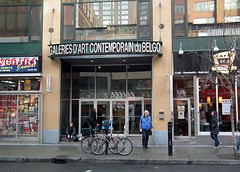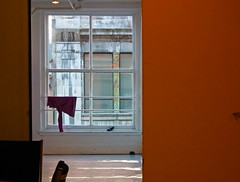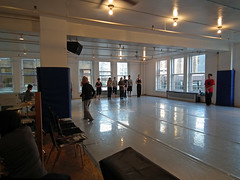If last April I had traveled to Yokohama with fears of exposure to nuclear radiation from Fukushima plant, why not face Montreal’s cold autumn this time? Master Yoshito Ohno had told me he’d come to Canada in November this year to perform “In Between” with Lucie Gregoire, a French Canadian contemporary dancer, as part of a trilogy they both have been creating since 2007. My experience in Yokohama had been crucial in my artistic path, so I did not hesitate at any point in going to see the show and if possible take a few more sessions, and so I went.
Two days before his performance, Yoshito Ohno’d gave an open Butoh class for students at LADMMI, L'École de Danse Contemporaine. It would be a class for students, yes, but some interested outsiders were admitted.
LADMMI is part of an art schools complex very close to the Place des Arts de Montreal, but independent from it, in one of the main shopping streets, Sainte Catherine. The building, in a forties style, has been remodeled to host art and dance schools and work spaces for everything having to do with bodywork and design; LADMMI is on the third floor and you can take a look from the street itself while some of the classes are happening.
 |
| LADMMI, Montreal (By Gustavo Thomas. 2011) |
The wait was long, since I had to be there early to make sure I was included among those coming from outside (in the end, we were only three outsiders). So that gave me time to wander around Sainte Catherine, observe some classes at the dance school and eventually discover the difference between my view of Butoh and that of a school of contemporary dance. Obviously, for the dance school, Butoh is a complement to the training of its dancers and, possibly, a way to develop a style in dance. For me, Butoh is a performing art in itself.
Yoshito Ohno arrived with his wife, a translator, Lucie Grégoire and the school principal; we were waiting for him, among a huge mass of students with different levels of training. Lucie apparently had transmitted some knowledge of Butoh to her groups, but not all of those students had had contact with Ohno’s discipline.
Master Ohno, obviously, didn’t remember who I was. He finally did it when I mentioned April, that I was Mexican and that I had taken his workshop in Yokohama. These are the curiosities of certain re-encounters, which I enjoy a lot.
I guessed Master Ohno would repeat most of his common exercises: the flower, the prayer, working with silk, etc. But the presence of dance students made me think I’d experience a kind of pedagogy of Butoh I did not know till that moment, a Butoh introductory class; and that was what he did.
It was an interesting class as a reminder of the rules of this art form, but also an example of teaching people these bases without having previous contact with Butoh.
Posture
The first thing Ohno (with help from the French translator) said was that we should understand the Japanese characters of man, heaven and earth, to identify our body as in the middle of two forces. He emphasized the image of a line passing through the center of the body to the crown and pulling us up, while the feet were “roots” that pull towards the earth. The chin pointing down and our gaze forward. With that posture, we were to walk. “Amazing Grace” was the first piece of music we worked with in this class.
He made a special comment about the hands; he spoke of the strength of the hands and fingers to remain together, with minimal separation. Then he took the idea of how those hands, that position, the chin down and the line between heaven and earth, were a hell to reach a presence on stage, a link between opposing forces.
We made several physical exercises as if pulling something and feeling the force, and then returning to the position and perceiving this new presence in us. This set of physical tensions initially left in us energy moving within us, and when standing, doing nothing, our body energy was charged without movement, what we call presence on stage.
The first thing Ohno (with help from the French translator) said was that we should understand the Japanese characters of man, heaven and earth, to identify our body as in the middle of two forces. He emphasized the image of a line passing through the center of the body to the crown and pulling us up, while the feet were “roots” that pull towards the earth. The chin pointing down and our gaze forward. With that posture, we were to walk. “Amazing Grace” was the first piece of music we worked with in this class.
He made a special comment about the hands; he spoke of the strength of the hands and fingers to remain together, with minimal separation. Then he took the idea of how those hands, that position, the chin down and the line between heaven and earth, were a hell to reach a presence on stage, a link between opposing forces.
We made several physical exercises as if pulling something and feeling the force, and then returning to the position and perceiving this new presence in us. This set of physical tensions initially left in us energy moving within us, and when standing, doing nothing, our body energy was charged without movement, what we call presence on stage.
The flower
In a case he had brought to the studio master Ohno had flowers for all, a lot of scented, artificial flowers. Then he spoke of the flower as the best example of what is standing between heaven and earth, in complete union. He asked us to move with the flowers. At some point he talked about being the flower, but did not elaborate on it. And we moved along with the music towards our flowers.
He asked us to carry the flower as if we were wind, and at the sound of our steps he asked us not to make noise, even when walking quickly, giving an example by doing it himself, saying there was no need to disturb the viewer's attention from our objective; our steps then followed the flower in the wind.
He told us how, early in his career, asked his father, Kazuo Ohno, to teach him to dance, and he replied giving him a flower and saying, “look, you don’t have to learn to dance, just seek to be a flower. Move with the flower. Do this every day; one day you will feel that you are that flower and will not need to have it in your hand any more.”
In a case he had brought to the studio master Ohno had flowers for all, a lot of scented, artificial flowers. Then he spoke of the flower as the best example of what is standing between heaven and earth, in complete union. He asked us to move with the flowers. At some point he talked about being the flower, but did not elaborate on it. And we moved along with the music towards our flowers.
He asked us to carry the flower as if we were wind, and at the sound of our steps he asked us not to make noise, even when walking quickly, giving an example by doing it himself, saying there was no need to disturb the viewer's attention from our objective; our steps then followed the flower in the wind.
He told us how, early in his career, asked his father, Kazuo Ohno, to teach him to dance, and he replied giving him a flower and saying, “look, you don’t have to learn to dance, just seek to be a flower. Move with the flower. Do this every day; one day you will feel that you are that flower and will not need to have it in your hand any more.”
The silk
Similarly, he took out from his case several small pieces of silk and gave them to us; each of us began to work with the idea of the strength and softness of silk, the strength and softness of our body. Moving from one state to another depending on the piece of silk we were stretching in our hands. That was our body and our interior; when strong, before stretching, as an adult, it was tense; as it stretched, it became soft, like a child asking for his mother.
As we were working on the technical aspects of the performance, he took from his bag Hokusai's painting “The Wave”. And he tried to explain the idea emanated from the painting: the artist, who has a different view of things, can see far away and can see up close, like an insect. We had to represent that in order to move, we had to find different views of our work. There was a technical search, but we had to feel the technical work too.
The piece of cloth
He gave each of us a piece of cloth, and we began to squeeze at the same time that our bodies squeezed, twisting with the piece of cloth. It was tension by stress, and the feeling of the texture of the fabric was to guide us in our squeezing movement, we had to work those points as the source of our movement and whatever came of it.
He made short mention of his theory of “forte pianissimo”, where the most complicated thing for the butokah is not to exploit but to maintain the strength of a possible explosion within while moving gently or slowly.
Squeezing the fabric was his way of addressing the “forte pianissimo” idea while moving.
The tissue
Then he showed us the image of the wooden sculpture of the Buddha of Nara. He showed the same photo he had in his studio in Yokohama as part of a calendar. Master Ohno made us note the sculpture's hands, hands that are never fully attached but are together within a separation the width of a sheet of paper.
He then offered us each a sheet of tissue paper and talked about the meeting of these hands together but separated, the same for our knees, and our arms in contact with the torso.
We practiced with that tissue paper for a while, but then he interrupted our work and asked us to add a pray to our movement; without further explanation besides saying that it wasn’t a religious thing, but a personal prayer, internal.
The music played for the final movement was the "Ave Maria" by Schubert, which his father always used in training and was the background music of one of his most famous pieces on the scene dedicated to his mother.
Farewell
At that moment, the time allotted for our class had run out and had to stop. Without saying more, Yoshito Ohno thanked us, saying that all the objects we worked with that day were a gift and we could keep them and should use them daily in our training; then he said goodbye. We all applauded to him, we were at a dance school and this is the way dance students are used to thank to their teachers.
Although Yokohama left me a profound and enlightening experience about Butoh, about its origins and technique, with this short open class in Montreal I discovered (or confirmed), from my point of view, the basis of the pedagogy of Yoshito Ohno for Butoh.
Now I also had something really tangible, physical, to support my daily training, a support as simple as an artificial flower, a piece of silk, a cloth and a small tissue. They will remind me, while working every day with them as physical objects, every of Yoshito’s words, and will be witnesses of my own development.
The performance Yoshito Ohno gave in Montreal together with Lucie Grégoire, “In Between”, will be part of another blog post.
Texts, photographs and videos in this Blog are all author's property, except when marked. All rights reserved by Gustavo Thomas.
If you have any interest in using any text, photograph or video from this Blog, for commercial use or not, please contact Gustavo Thomas at gustavothomastheatre@gmail.com.









No comments:
Post a Comment